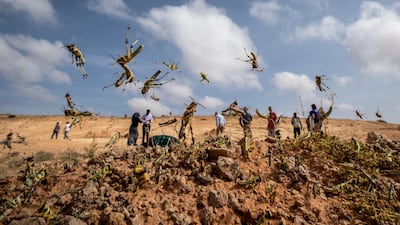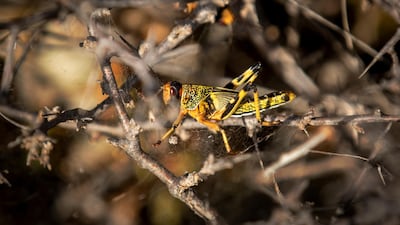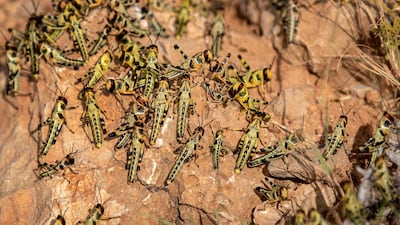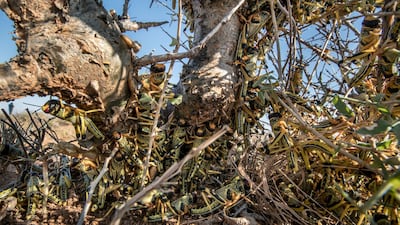The United Nations is to test drones equipped with mapping sensors and atomisers to spray pesticides in parts of East Africa battling an invasion of desert locusts that are ravaging crops and exacerbating a hunger crisis.
Hundreds of millions of the voracious insects have swept across Ethiopia, Somalia and Kenya in what the UN has called the worst outbreak in a quarter of a century, with Uganda, Eritrea and Djibouti also affected.
Authorities in those countries are already spraying pesticides from the air, but experts say the scale of the infestation is beyond local capacity as desert locusts can travel up to 150 kilometres a day.
They threaten to increase food shortages in a region where up to 25 million people are reeling from three consecutive years of droughts and floods, aid agencies say.
Keith Cressman, senior locust forecasting officer at the UN Food and Agriculture Organisation, said specially developed prototypes would be tested that can detect swarms using special sensors and adapt their speed and height accordingly.
“Nobody’s ever done this with desert locusts before, so we have no proven methodology for using drones for spraying on locusts,” Mr Cressman said.
“There are already small atomiser sprayers made for drones. But with locusts, we just don’t know how high and how fast to fly.”
The swarms – one reportedly measuring 40km by 60km – have already devoured tens of thousands of hectares of crops such as maize, sorghum and teff, and ravaged pasture for livestock.
By June, the fast-breeding locusts could multiply by 500 times and move into South Sudan.
The impact on the region’s food supply could be enormous – a locust swarm of one square kilometre can eat the same amount of food in one day as 35,000 people, the FAO says.
Climate scientists say global warming may be behind the current infestations, which have also hit parts of Iran, India and Pakistan.
Warmer seas have resulted in a rise in the frequency of cyclones in the Indian Ocean. This has caused heavy downpours on the Arabian Peninsula, creating the ideal conditions for locust breeding in the deserts of Oman, Yemen and Saudi Arabia.
Researchers are increasingly looking to technology to provide early warning signs and control locust outbreaks amid fears climate change could bring more cyclones.
Officials in Kenya say drones could play an important role given the limited number of aircraft.
“Every county wants an aircraft, but we have only have five at the moment and they can only be in one location at one time,” said David Mwangi, head of plant protection at Kenya’s ministry of agriculture.
“We have not used drones before, but I think it’s worth testing them as they could help.”
Existing drone models are restricted in terms of the volume of fuel and pesticide they can carry, and the distances they can cover because of their size and battery life, say entomologists and plant protection researchers.
Another challenge for drone use in such emergencies is the lack of regulation. Many East African countries are still in the early stages of drafting laws, prohibiting their use unless in exceptional circumstances and with strict approvals.
That makes it harder to deploy larger drones, which have petrol-powered engines capable of carrying tanks of up to 1,500 litres and travelling distances of up to 500km, and often require special approval.
Drones can also be used in the aftermath of an infestation.
“The other use case for drones is in post-disaster mapping,” said Kush Gadhia from Astral Aerial Solutions, a Kenyan company that uses drones to address development challenges.
“Governments need to know the extent of the damage afterwards. Combining larger satellite maps with smaller drone maps, which provide higher-resolution images, will give more accurate assessments on the extent of crop loss and health.”
TOURNAMENT INFO
2018 ICC World Twenty20 Asian Western Regional Qualifier
The top three teams progress to the Asia Qualifier
Thursday results
UAE beat Kuwait by 86 runs
Qatar beat Bahrain by five wickets
Saudi Arabia beat Maldives by 35 runs
Friday fixtures
10am, third-place playoff – Saudi Arabia v Kuwait
3pm, final – UAE v Qatar
Dengue%20fever%20symptoms
%3Cp%3EHigh%20fever%20(40%C2%B0C%2F104%C2%B0F)%3Cbr%3ESevere%20headache%3Cbr%3EPain%20behind%20the%20eyes%3Cbr%3EMuscle%20and%20joint%20pains%3Cbr%3ENausea%3Cbr%3EVomiting%3Cbr%3ESwollen%20glands%3Cbr%3ERash%26nbsp%3B%3C%2Fp%3E%0A
Babumoshai Bandookbaaz
Director: Kushan Nandy
Starring: Nawazuddin Siddiqui, Bidita Bag, Jatin Goswami
Three stars
Killing of Qassem Suleimani
COMPANY%20PROFILE
%3Cp%3E%3Cstrong%3ECompany%20name%3A%3C%2Fstrong%3E%20Klipit%3C%2Fp%3E%0A%3Cp%3E%3Cstrong%3EStarted%3A%3C%2Fstrong%3E%202022%3C%2Fp%3E%0A%3Cp%3E%3Cstrong%3EFounders%3A%3C%2Fstrong%3E%20Venkat%20Reddy%2C%20Mohammed%20Al%20Bulooki%2C%20Bilal%20Merchant%2C%20Asif%20Ahmed%2C%20Ovais%20Merchant%3C%2Fp%3E%0A%3Cp%3E%3Cstrong%3EBased%3A%3C%2Fstrong%3E%20Dubai%2C%20UAE%3C%2Fp%3E%0A%3Cp%3E%3Cstrong%3EIndustry%3A%3C%2Fstrong%3E%20Digital%20receipts%2C%20finance%2C%20blockchain%3C%2Fp%3E%0A%3Cp%3E%3Cstrong%3EFunding%3A%3C%2Fstrong%3E%20%244%20million%3C%2Fp%3E%0A%3Cp%3E%3Cstrong%3EInvestors%3A%3C%2Fstrong%3E%20Privately%2Fself-funded%3C%2Fp%3E%0A
Skoda Superb Specs
Engine: 2-litre TSI petrol
Power: 190hp
Torque: 320Nm
Price: From Dh147,000
Available: Now
Profile of VoucherSkout
Date of launch: November 2016
Founder: David Tobias
Based: Jumeirah Lake Towers
Sector: Technology
Size: 18 employees
Stage: Embarking on a Series A round to raise $5 million in the first quarter of 2019 with a 20 per cent stake
Investors: Seed round was self-funded with “millions of dollars”
Global state-owned investor ranking by size
|
1.
|
United States
|
|
2.
|
China
|
|
3.
|
UAE
|
|
4.
|
Japan
|
|
5
|
Norway
|
|
6.
|
Canada
|
|
7.
|
Singapore
|
|
8.
|
Australia
|
|
9.
|
Saudi Arabia
|
|
10.
|
South Korea
|
How to apply for a drone permit
- Individuals must register on UAE Drone app or website using their UAE Pass
- Add all their personal details, including name, nationality, passport number, Emiratis ID, email and phone number
- Upload the training certificate from a centre accredited by the GCAA
- Submit their request
What are the regulations?
- Fly it within visual line of sight
- Never over populated areas
- Ensure maximum flying height of 400 feet (122 metres) above ground level is not crossed
- Users must avoid flying over restricted areas listed on the UAE Drone app
- Only fly the drone during the day, and never at night
- Should have a live feed of the drone flight
- Drones must weigh 5 kg or less
Company Profile
Name: Thndr
Started: 2019
Co-founders: Ahmad Hammouda and Seif Amr
Sector: FinTech
Headquarters: Egypt
UAE base: Hub71, Abu Dhabi
Current number of staff: More than 150
Funds raised: $22 million
ICC Women's T20 World Cup Asia Qualifier 2025, Thailand
UAE fixtures
May 9, v Malaysia
May 10, v Qatar
May 13, v Malaysia
May 15, v Qatar
May 18 and 19, semi-finals
May 20, final
More from Neighbourhood Watch:
SUE%20GRAY'S%20FINDINGS
%3Cp%3E%22Whatever%20the%20initial%20intent%2C%20what%20took%20place%20at%20many%20of%20these%20gatherings%20and%20the%3Cbr%3Eway%20in%20which%20they%20developed%20was%20not%20in%20line%20with%20Covid%20guidance%20at%20the%20time.%3C%2Fp%3E%0A%3Cp%3E%22Many%20of%20these%20events%20should%20not%20have%20been%20allowed%20to%20happen.%20It%20is%20also%20the%20case%20that%20some%20of%20the%3Cbr%3Emore%20junior%20civil%20servants%20believed%20that%20their%20involvement%20in%20some%20of%20these%20events%20was%20permitted%20given%20the%20attendance%20of%20senior%20leaders.%C2%A0%3C%2Fp%3E%0A%3Cp%3E%22The%20senior%20leadership%20at%20the%20centre%2C%20both%20political%20and%20official%2C%20must%20bear%20responsibility%20for%20this%20culture.%C2%A0%3C%2Fp%3E%0A%3Cp%3E%22I%20found%20that%20some%20staff%20had%20witnessed%20or%20been%20subjected%20to%20behaviours%20at%20work%20which%20they%20had%20felt%20concerned%20about%20but%20at%20times%20felt%20unable%20to%20raise%20properly.%3C%2Fp%3E%0A%3Cp%3E%22I%20was%20made%20aware%20of%20multiple%20examples%20of%20a%20lack%20of%20respect%20and%20poor%20treatment%20of%20security%20and%20cleaning%20staff.%20This%20was%20unacceptable.%22%C2%A0%3C%2Fp%3E%0A
The%20specs
%3Cp%3E%3Cstrong%3EEngine%3A%20%3C%2Fstrong%3E3.5-litre%20twin-turbo%20V6%20%0D%3Cbr%3E%3Cstrong%3EPower%3A%20%3C%2Fstrong%3E456hp%20at%205%2C000rpm%0D%3Cbr%3E%3Cstrong%3ETorque%3A%20%3C%2Fstrong%3E691Nm%20at%203%2C500rpm%0D%3Cbr%3E%3Cstrong%3ETransmission%3A%20%3C%2Fstrong%3E10-speed%20auto%20%0D%3Cbr%3E%3Cstrong%3EFuel%20consumption%3A%20%3C%2Fstrong%3E14.6L%2F100km%0D%3Cbr%3E%3Cstrong%3EPrice%3A%20%3C%2Fstrong%3Efrom%20Dh349%2C545%0D%3Cbr%3E%3Cstrong%3EOn%20sale%3A%20%3C%2Fstrong%3Enow%3C%2Fp%3E%0A
Key products and UAE prices
iPhone XS
With a 5.8-inch screen, it will be an advance version of the iPhone X. It will be dual sim and comes with better battery life, a faster processor and better camera. A new gold colour will be available.
Price: Dh4,229
iPhone XS Max
It is expected to be a grander version of the iPhone X with a 6.5-inch screen; an inch bigger than the screen of the iPhone 8 Plus.
Price: Dh4,649
iPhone XR
A low-cost version of the iPhone X with a 6.1-inch screen, it is expected to attract mass attention. According to industry experts, it is likely to have aluminium edges instead of stainless steel.
Price: Dh3,179
Apple Watch Series 4
More comprehensive health device with edge-to-edge displays that are more than 30 per cent bigger than displays on current models.








